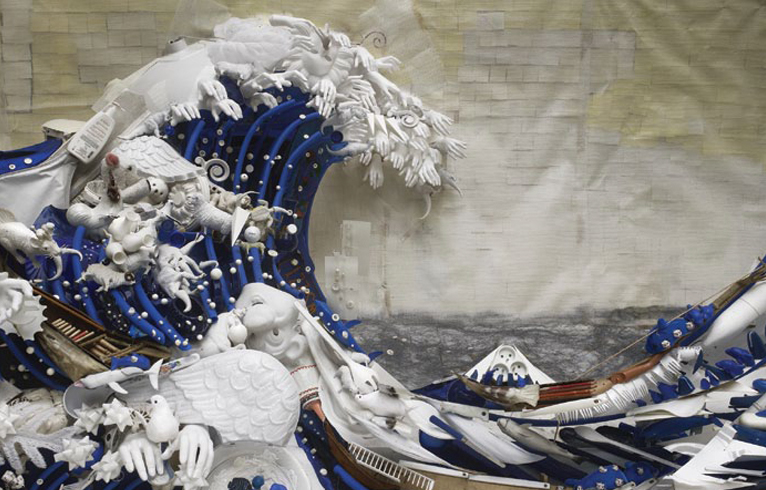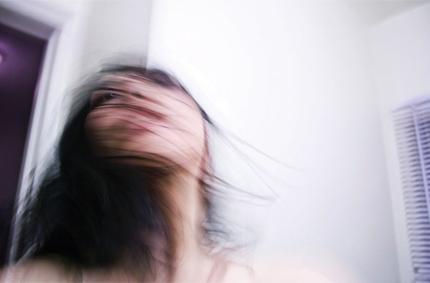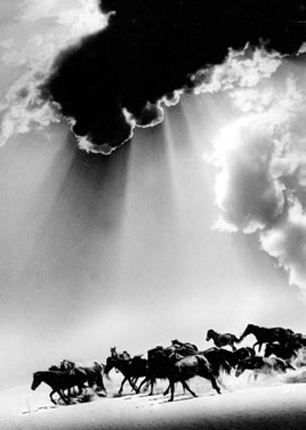CAOCHANGDI PHOTOSPRING 2011
| August 3, 2011 | Post In LEAP 9

Following artist Rong Rong’s lead, people have flocked into the little village of Caochangdi from all corners of the photography world. Right after the conclusion of the opening ceremony, the recipients of three much-anticipated awards were finally announced. Twenty-two year old female photographer Zhe Chen was awarded the Three Shadows Photography Award; Luo Dan (see LEAP 8) received the Tierney Fellowship; The Shiseido Prize for Best Female Photographer went to Chu Chu. For Caochangdi— situated out in Beijing’s suburbs— this is likely one of the most lively days of the year. The biggest names in photography, internationally recognized connoisseurs of the art world, the media and amateur enthusiasts alike all gathered for the event.
Zhe Chen received the festival’s big prize this year— a very “Three Shadows” choice. This is not to cast doubt on the fairness of the awards process; a degree of partiality and distinctive style is a natural part of selection for any photo prize. For many years, Three Shadows Photography Art Centre has been devoted to unearthing cutting-edge up-and-comers in photography, paying special attention to young photographers whose strengths lie in experimental and conceptual work; nearly all of the contestants this year were under thirty. Born in 1989, Zhe Chen— a recent graduate of Pasadena’s Art Center College of Design— won over the judges with her series “The Bearable.” The body is Zhe Chen’s expressive medium; she is infatuated with self-inflicted pain and injury, and engages in detailed self-scrutiny. However, she is not the only one who focuses on this kind of subject matter or treats it in this way— Lin Zhipeng (who works under the name 223) and Ren Hang have approaches that often have points of overlap. This common theme seems to attest to the standing of so-called “private photography” on the Mainland; this recognition might not be “official,” but it does hold a gradually growing say in what or who is avant-garde. There is nothing wrong with being young— at the start of their careers, Rong Rong and Liu Zheng were no more than rebellious twenty-somethings, and yet during the ruling days of documentary they set off a revolution in the photography world using their bodies, concepts, and actions.

Looking from Rong Rong to this new generation of photographers one can glimpse a cross-section of photography’s evolution in China over the past twenty years. Rong Rong’s retrospective at Chambers Fine Art entitled “Rong Rong’s Ruin Pictures: 1996-1998” makes as forceful an impact as ever. In these works, the body is entangled in the weighty chaos of its surrounding reality. Even figures that have yet to materialize seem to be in a kind of antagonistic negotiation with the ruins; it is nearly impossible to comprehend the photographs from the standpoint of their portrait images alone. None of the images stand on their own, as neither body nor portrait can be autarkic: each is just a medium through which we return once again to face a stifling reality. In contrast, the “private photography” of recent years presents a body that has little to do with external entities. Nearly devoid of any background in reality, the images speak their own self-sufficient language. This is a new generation of photographers who do their work for themselves or for other young people facing similar questions. The youths in these photographs are immersed in their moods and personal relationships; the camera is for the individual. At the same time, there is a common “type” that emerges across their works, as this is a generation of young people who share the experience of growing up in a big city.
These words may seem to pass judgment on the narcissism of this mode of self-mutilation. But in fact, the photographers are engaging in self-exploration precisely by breaking through this kind of restriction or taboo. They brush aside the threat of antagonism towards their work, and begin to observe and express with complete freedom. The body is no longer a medium. It is the world itself; it is the imprint of the heart. In the past several decades “the self” has been difficult to come by in our visual culture. Amidst our archive of images, we can only hope to find politics, landscapes, people, and— though it looms indistinctly and only gradually appears with some kind of clarity— “society.” But here, a kind of raw, unobstructed state of being has emerged. I am inclined to regard “private photography” as an attempt to lift up the veil. The work has only just begun, and possibilities for images and expression have only just begun to reveal themselves. Reality and self— or body— are not necessarily on separate sides of the balance. Once you enter into the world of a work of art, it is nothing more than a set of mirror images. The real key is considering the people and the lives behind them.
I worry that this kind of commentary results in a kind of “generational” misconception or a “periodization.” The notion of a generation of artists making the images of an era is often a mistaken one. Art is always first and foremost a matter of the individual. Zhe Chen is not the representative of a generation of new photographers; she is just one young photographer— granted, one with great potential and of whom great things are expected. Nor can The Three Shadows Award represent “contemporary photography” at large; Three Shadows is merely starting a dialogue, and making its own preferences clear. But beyond Three Shadows’ cutting edge there is a group of young photographers doing work that calls on the past and on the depths of tradition. Luo Dan’s “Simple Song” wet-plate photographs of Christians on the Nujiang won the Tierney Fellowship; Wei Bi’s “Meng Xi” weaves calligraphy and photography into one long scroll, in the spirit of a Song or Yuan vernacular script. Indeed, the notion that cutting-edge and tradition cannot intermix is as much of a fallacy as the binary opposition between society and self. Most worthy of praise is Taca’s work. Carefully suspended between classical Chinese landscapes and individualized abstraction, he strikes a difficult balance between the airtight language of photography and the poetics of the Chinese tradition. Without sufficient caution this sort of classical pursuit could very well slip into the realm of a more literary conveyance of emotion. Instead, it remains aptly temperate and self-aware.

If we talk about the Three Shadows Award, we cannot go without mentioning the collaboration between the Japanese photography world and the Arles Photography Festival. Rong Rong and inri made an undeniable contribution by inviting the godfather of Japanese photography Eikoh Hosoe to serve as panel judge. There is a discernible though subtle relationship between his work and that of Zhe Chen; at the very least, both share an interest in the image of the body as a medium. Nevertheless, his trip to China serves more as a testament to his overall influence. Daido Moriyama, Nobuyoshi Araki, and Eikoh Hosoe are Japanese masters whose works have circulated for quite some time among young photographers growing up in the urban context. Yamamoto Masao is another of PhotoSpring’s highlights. Yamamoto is extremely adept not only at maximizing the potential of space, but also at putting it to new use. With every detail— the distance between photographs, the way they are positioned, the spatial dimensions unique to each— he has extended two-dimensional photography out into three-dimensional spatial and installation art.
As the birthplace of the photography festival, Arles’ initiative to globalize the event came early when they held a festival featuring China in 1988. In Caochangdi, the same sort of international reach not only brings in artists and exhibitions with notable authority, but is also an important step forward in identity building for third-world countries. To that end, “Africa: See you! See me!” is a good reference for the Chinese photography world. A collection of works from that continent, it uses images to differentiate between self-identification and citizenship construction. Though “recording” is the first step in the process of construction, contemporary photography has now developed in a way that enables it to use an alternative language for posing questions about and cross-examining this very construction. In his ShanghART solo exhibition, Yang Zhenzhong further investigates the dubiousness of identity construction. Subjects of the new photographic series “Wrong Way Round” all wear their clothes or uniforms from back-to-front; each double portrait consists of one photograph of a person facing the camera and one of with his or her back to the camera. The sight of a uniform and the concealment of a face, or the sight of a face and backwards clothing: together they generate a richly profound contrast. If using images to engage in identity construction is an optimistic effort, then Yang Zhenzhong pops the bubble and lays bare the absurdity and arbitrary nature of this construction. The behavior of construction itself tends toward stability and order, but entropy and futility are shadows that follow close behind.
“Reappearance: The Arles 1988 China Exhibition Symposium” is an opportune juncture for examining the development of the contemporary Chinese photography of the 1980s. Wu Yinxian, Xia Yongjie, Chen Baosheng, Ling Fei, Gao Yuan, and Zhang Hai’er were all participating photographers in the 1988 Arles Photography Festival. Some were classic documentary photographers, while others set new precedents for documentary photography by merging subjective and conceptual elements. Recollection is both a reaffirmation of historical legitimacy as well as a journey back in search of other possibilities. This year, most worthy of a “rectification of names” is none other than Ren Shulin. His long-popular “The Innocent in the 80s” was formally shown here for the first time. The venue, Inter Art Center and Gallery, effectively turns the clock back three decades with nostalgic placards, rows of old desks and chairs, and red slogan banners: “Our Homeroom, Forever Fighting In Unity and Fraternity.” Some see these pictures and think of their own youth; others reminisce over an idealized past. Seen through Ren’s lens, these are young people growing up in the 1980s, in the spring of their youth. Though on the one hand an official debut of indie 1980s nostalgia, the photographs themselves possess a significance that transcends mere trend. As Ren carefully captured images of middle school students, the Chinese photography world was still consumed by more “classic” themes. Very few people were able to aim their lenses head-on at the stage of life that is youth, and even fewer were able to find the right photographic language to accompany it. Fortunately, Ren found his own poetic mode of documentary. The language of his images, the physicality of his subjects, the color, composition, and spatial relationships in each of his works: it is all unparalleled even in the context of Chinese photography today. Contrasting this simple silhouette of youth with the cruel story of youth showcased by Three Shadows, one is left with some impression of the changes that have taken place in photography and in popular consciousness over the past 30 years.
A successful photography festival interacts with its local cultural environment. What we need is a PhotoSpring that is local— one that belongs to Caochangdi— and not an “Arles in Beijing.” In this globalized era, an event like this need not be a unidirectional cultural broadcast. With the Internet, these young photographers have access to the same information, and at the same pace as do all other international photographers. Collaboration is now more than ever, about exchanging methodologies and of modes of applying them. If what Three Shadows Photography Center did last year at the first annual PhotoSpring was provide a platform for exchange, this year’s edition began to take a clear position and direction— both in terms of awards selection and curatorial concept. Duan Lingyu (Translated by Katy Pinke)

